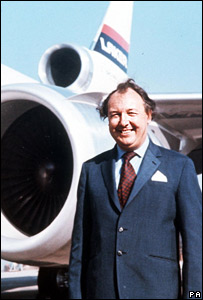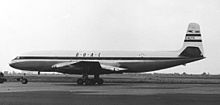
An airline is a company that provides air transport services for traveling passengers and freight. Airlines use aircraft to supply these services and may form partnerships or alliances with other airlines for codeshare agreements, in which they both offer and operate the same flight. Generally, airline companies are recognized with an air operating certificate or license issued by a governmental aviation body. Airlines may be scheduled or charter operators.

Pan American World Airways, originally founded as Pan American Airways and commonly known as Pan Am, was the principal and largest international air carrier and unofficial overseas flag carrier of the United States for much of the 20th century. It was the first airline to fly worldwide and pioneered numerous innovations of the modern airline industry, such as jet aircraft, jumbo jets, and computerized reservation systems. Until its dissolution in 1991, Pan Am "epitomized the luxury and glamour of intercontinental travel", and it remains a cultural icon of the 20th century, identified by its blue globe logo, the use of the word "Clipper" in its aircraft names and call signs, and the white uniform caps of its pilots.

Shannon Airport is an international airport located in County Clare in the Republic of Ireland. It is adjacent to the Shannon Estuary and lies halfway between Ennis and Limerick. The airport is the third busiest airport in the Republic of Ireland, and the fifth busiest on the island.

Sir Frederick Alfred Laker was an English airline entrepreneur, best known for founding Laker Airways in 1966, which went bankrupt in 1982. Known as Freddie Laker, he was one of the first airline owners to adopt the "low cost / no-frills" airline business model that has since proven to be very successful worldwide with companies such as Norwegian Air, Ryanair, easyJet, AirAsia and WestJet.
British Caledonian (BCal) was a British private independent airline which operated out of Gatwick Airport in south-east England during the 1970s and 1980s. It was created as an alternative to the British government-controlled corporation airlines and was described as the "Second Force" in the 1969 Edwards report. It was formed by the UK's second-largest, independent charter airline Caledonian Airways taking over British United Airways (BUA), then the largest British independent airline and the United Kingdom's leading independent scheduled carrier. The carrier slogan was Let's go British Caledonian in the 1970s and We never forget you have a choice in the 1980s. The BUA takeover enabled Caledonian to realise its long-held ambition to transform itself into a scheduled airline. The merged entity eventually became the UK's foremost independent, international scheduled airline.

Ghana Airways Limited was the flag carrier of Ghana, with its main base of operation and hub at Kotoka International Airport in Accra. The airline ceased operations in 2004, although plans were discussed to revive it in 2020 in partnership with Egyptair.
The freedoms of the air are a set of commercial aviation rights granting a country's airlines the privilege to enter and land in another country's airspace. They were formulated as a result of disagreements over the extent of aviation liberalisation in the Convention on International Civil Aviation of 1944, known as the Chicago Convention. The United States had called for a standardized set of separate air rights to be negotiated between states, but most other countries were concerned that the size of the U.S. airlines would dominate air travel if there were not strict rules. The freedoms of the air are the fundamental building blocks of the international commercial aviation route network. The use of the terms "freedom" and "right" confers entitlement to operate international air services only within the scope of the multilateral and bilateral treaties that allow them.

Caledonian Airways was a wholly private, independent Scottish charter airline formed in April 1961. It began with a single 104-seat Douglas DC-7C leased from Sabena. Caledonian grew rapidly over the coming years to become the leading transatlantic "affinity group" charter operator by the end of the decade. During that period, passenger numbers grew from just 8,000 in 1961 to 800,000 in 1970. The latter represented 22.7% of all British non-scheduled passengers. It also became Britain's most consistently profitable and financially most secure independent airline of its era, never failing to make a profit in all its ten years of existence. By the end of 1970, Caledonian operated an all-jet fleet consisting of eleven aircraft and provided employment for over 1,000 workers. At that time, its principal activities included group charters between North America, Europe and the Far East using Boeing 707s, and general charter and inclusive tour (IT) activities in Europe utilising One-Elevens. This was also the time Caledonian merged with British United Airways (BUA), the largest contemporary independent airline and leading private sector scheduled carrier in the United Kingdom, and formed British Caledonian.
A transatlantic flight is the flight of an aircraft across the Atlantic Ocean from Europe, Africa, South Asia, or the Middle East to North America, Central America, or South America, or vice versa. Such flights have been made by fixed-wing aircraft, airships, balloons and other aircraft.

Laker Airways was a private British airline founded by Sir Freddie Laker in 1966. It was originally a charter airline flying passengers and cargo worldwide. Its head office was located at Gatwick Airport in Crawley, England.
Cabotage is the transport of goods or passengers between two places in the same country. It originally applied to shipping along coastal routes, port to port, but now applies to aviation, railways, and road transport as well.
Bermuda II was a bilateral air transport agreement between the governments of the United Kingdom and the United States signed on 23 July 1977 as a renegotiation of the original 1946 Bermuda air services agreement. A new open skies agreement was signed by the United States and the European Union (EU) on 30 April 2007 and came into effect on 30 March 2008, thus replacing Bermuda II.

An air transport agreement is a bilateral agreement to allow international commercial air transport services between signatories.

American Overseas Airlines (AOA) was an airline that operated between the United States and Europe between 1945 and 1950. It was headquartered in Midtown Manhattan, New York City.
The EU–US Open Skies Agreement is an open skies air transport agreement between the European Union (EU) and the United States (US). The agreement allows any airline of the European Union and any airline of the United States to fly between any point in the European Union and any point in the United States. Both EU and US airlines are allowed to fly on to a further destination in another country after their initial stop. Because the EU is not treated as a single territory for the purposes of the agreement, this means in practice that US airlines can fly between two points in the EU as long as that flight is the continuation of a flight that started in the US. Airlines of the EU are also allowed to fly between the US and non-EU countries that are part of the European Common Aviation Area, like Switzerland. EU and US airlines can operate all-cargo flights under Seventh Freedom rights, meaning US airlines' all-cargo flights can be operated from one EU country to any other country and EU airlines' all-cargo flights can operate between the US and any other country. Norway and Iceland acceded to the Agreement from 2011 and their airlines enjoy the same rights as EU airlines.
A legacy carrier, in the United States, is an airline that had established interstate routes before the beginning of the route liberalization permitted by the Airline Deregulation Act of 1978 and so was directly affected by that Act. Legacy carriers are distinct from low-cost carriers, which, in the United States, are generally new airlines and were started to compete in the newly deregulated industry.

British Eagle International Airlines was a major British independent airline that operated from 1948 until it went into liquidation in 1968. It operated scheduled and charter services on a domestic, international and transatlantic basis over the years.
British Caledonian (BCal) came into being in November 1970 when the Scottish charter airline Caledonian Airways, at the time Britain's second-largest, wholly privately owned, independent airline, took over British United Airways (BUA), then the largest British independent airline as well as the United Kingdom's leading independent scheduled carrier.
There are bilateral treaties that govern aviation rights between the United States and China, which cover both passenger services and cargo services. The United States has liberal aviation agreements with many countries but not China, Japan, South Africa, and some South American countries. However, there is no "open skies" agreement between China and the US, which generally refers to an agreement that allows unrestricted flights between countries. The current US-China treaty specifies the number of flights permitted. Due to the highly regulated nature of awards for route authority between the two countries and the strict limits on number of flights, the application process is competitive. US airlines have sought to gain support from local politicians and the general public to influence the US government into awarding routes.

The history of Scandinavian Airlines System (SAS) from 1933 to 1951 covers the first attempts at transatlantic travel, the establishment of a consortium and finally the establishment of the consolidated SAS. Aerotransport, the national airline of Sweden, and Det Norske Luftfartselskap (DNL), the national airline of Norway, both started planning transatlantic routes in the mid-1930s. By 1939, negotiations were started with Det Danske Luftfartselskab (DDL) of Denmark, and by 1940 services were to begin. Because of the German occupation of Denmark and Norway, the plans collapsed. In Sweden, Svensk Interkontinental Lufttrafik (SILA) was founded to start private transatlantic flights, which commenced in 1945. Negotiations were started again, and in 1946 the consortium Overseas Scandinavian Airlines System (OSAS) was established to start routes to New York and South America.













